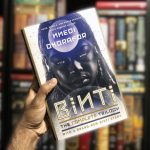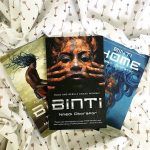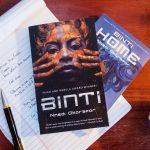
The series of novellas collectively known as the Binti trilogy served as my personal introduction to Afrofuturism. I have always been a member of the sci-fi fandom, and at first, I was merely excited to have found a new sub-genre. At the time, I was unaware of the complexities of the social hierarchies being commented upon, and the vital importance of the narratives being portrayed in a much different light than what I had been used to seeing in science fiction written primarily by white, cisgender, heterosexual men. Whenever I had seen a character of color in a novel, whether Afrodiasporic or of another, non-Caucasian race/ethnicity, they generally served as a plot device, a stereotype, or were otherwise reduced to little more than a caricature supposedly representative of their entire race or people.
I began to casually research the genre of Afrofuturism, and found a wealth of literature, from novels to short stories to academic papers, as well as art, music, sculpture, and other forms of cultural expression.

As a queer woman, I was particularly interested in the intersection of LGBTQIA+ representation and the canon of Afrodiasporic literature, particularly as it pertained to Afrofuturism, Black Sci-Fi, and African Speculative Fiction.
In “’Isn’t Realist Fiction Enough?’: On African Speculative Fiction” (Joshua Yu Burnett), Gwen Ansel is quoted as saying that Afrofuturist literature should be promoted because “children need to stop reading Charles Dickens.” (Burnett, 121) However, a more moderate stance is taken by Burnett, who suggests that children should not be forced to read Charles Dickens and his contemporaries, who largely consisted of white, heterosexual men of Western European descent, at the exclusion of a more diverse range of voices – literature from people of every ethnicity and any nationality, from authors who identify as LGBQTIA+, from writers who are neurodivergent or differently-abled, and from authors who hail from a wide spectrum of socioeconomic backgrounds.

There is a concept in computing known as data bias. In short, it happens when a set of data is accumulated from past years and decades, but is not representative of the entire population in some way, shape, or form. This data is then fed into an artificially intelligent algorithm, which perpetuates the biases of the past into the future. I strongly suspect that people, too, are subject to data bias. When every scientist depicted in popular media is a ‘lovably eccentric’ man of European descent, complete with spectacles and a lab coat, is it any wonder that more women, LGBTQIA+ individuals, Afrodiasporic peoples, Latinos and Latinas, indigenous populations, and people from elsewhere on the range of human diversity do not go into STEM fields?

The same holds true for literature. Our biases are self-perpetuating. They are taught in school and reinforced by the media. They are also incredibly damaging to so many people, which is why it is vitally important, now more than ever, to imagine futures where everyone is represented, and diversity is more than just a buzzword or a token character haphazardly tossed into the narrative and promptly forgotten about by Act 2.
In the Binti triology, the Himba are depicted are isolationist, but not to the point where they had been left behind as technological advancements swept the Earth. It is revealed that Himba people rarely go off-world in Nnedi Okorafor’s imagined future, and themes of home – from Binti’s homeland to her homeworld to the physical home she resided in for most of her life are frequently touched upon. At the very start of the novel, Binti gives thanks to the land and to the Earth. For the first time ever, she is leaving home. And for the last time in her life, she is nothing more or less than human; she is Himba, and Himba alone. “I swiped the otjize from my forehead with my index finger and knelt down,” Binti narrates. “Then I touched the finger to the sand, grounding the sweet smelling red clay into it. “Thank you,” I whispered.” (Binti, 1)
On Earth, Binti had been a master harmonizer, so skilled in mathematics that she was accepted into the most prestigious university in the galaxy. The other Himba individuals in the story, Binti’s friends and relatives and neighbors, embrace technology alongside tradition. The balance between the two is, at times, delicate, and Binti defies tradition in order to leave to go to Oozma Uni.
In Bernett’s words, “The binary of past/“tribal” versus future/technological here collapses because Okorafor’s speculative Himba are both.” (Bernett, 128) However, it is noted later on in the first book of the trilogy that not all inhabitants of the galaxy felt the same. “’Tribal’: that is what they called the humans from ethnic groups too remote and “uncivilized” to regularly send students to attend Oomza Uni.” (Binti, 51)

The dichotomy between tribality and technological progress seen in the book can be viewed as an allegory for colonialism and imperialism in the real world. Often, colonizers used words such as “savage,” “primitive,” “heathen” and “uncivilized” to describe that which they did not understand and that which they wished to subjugate. In Okorafor’s future, fictional Africa, the Himba are empowered by technology but still hold their ancient customs sacred, and they are seen as lesser-than for this by other humans and other Peoples of the galaxy.
This is very much a commentary on the expectations placed upon tribal groups. They are expected to adopt technology (and, by extension, the dominant narrative perpetrated by a society that views itself as superior to theirs in every way) at the expense of their own customs, traditions, rituals, and beliefs. The Himba in Binti have managed to find a way to blend the past with the future, the new with the old, the traditions going back generations with the latest new technologies.
It is this unique balance between Binti’s past and her future that allows her to survive aboard the Meduse-occupied ship. Her edan, an object the Khoush students had shown no interest in, saved her life. Additionally, Binti’s willingness to evolve, grow, and change is a cornerstone of the trilogy, leading to Binti becoming more – more than Himba, more than human, as well as ‘other.’





